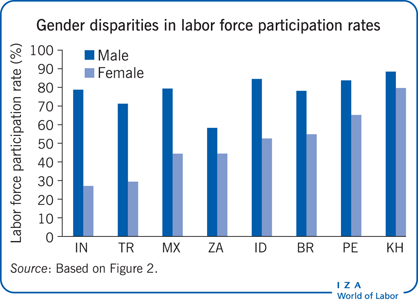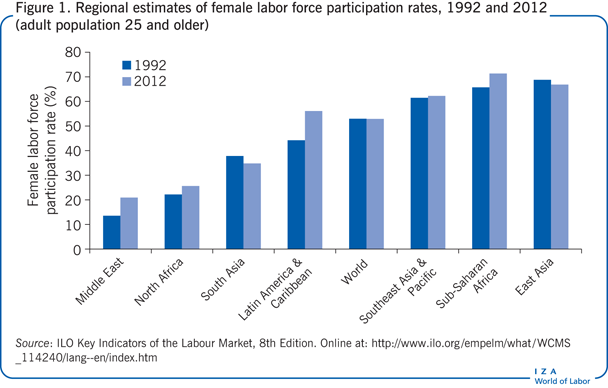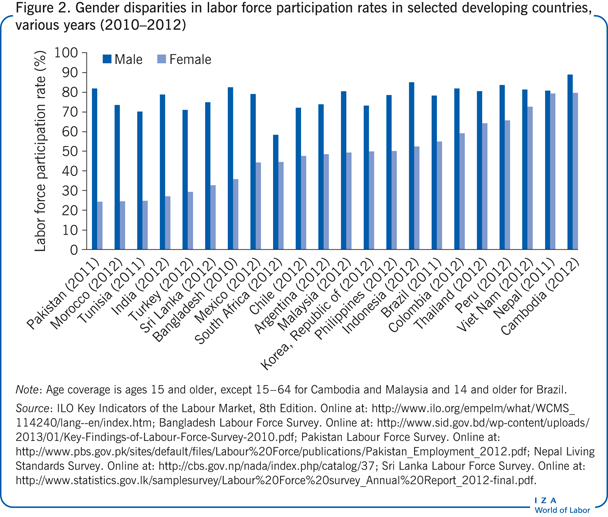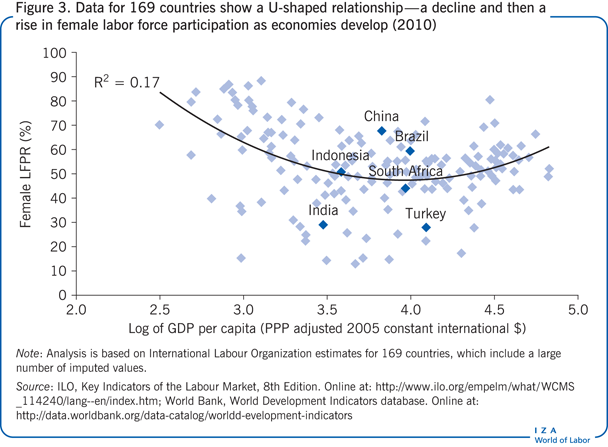Elevator pitch
While women’s labor force participation tends to increase with economic development, the relationship is not straightforward or consistent at the country level. There is considerably more variation across developing countries in labor force participation by women than by men. This variation is driven by a wide variety of economic and social factors, which include economic growth, education, and social norms. Looking more broadly at improving women’s access to quality employment, a critical policy area is enhancing women’s educational attainment beyond secondary schooling.

Key findings
Pros
Female labor force participation is an important driver (and outcome) of growth and development.
Women join the workforce in developing countries as a coping mechanism in response to shocks.
The participation of women is the outcome of various macro and individual factors.
Access to quality education (beyond secondary) is critical to improve employment outcomes for women.
Cons
In developing countries, high female labor force participation rates typically reflect poverty.
Women earn less than men and are more likely to be engaged in unprotected jobs, such as domestic work.
Education raises the reservation wage and expectations of women, but it needs to be matched by job creation.
Underreporting is common, so data on women’s participation rates do not accurately reflect women’s work.
Author's main message
The relationship between women’s participation in the labor force and development is complex and reflects changes in economic activity, educational attainment, fertility rates, social norms, and other factors. Standard labor force participation rates paint only a partial picture of women’s work. More important is understanding the quality of women’s employment. To achieve gains in employment quality, policies need to focus on both labor demand and supply dimensions. Expanding access to secondary and higher education is particularly relevant.
Motivation
Women’s participation in the labor market varies greatly across countries, reflecting differences in economic development, social norms, education levels, fertility rates, and access to childcare and other supportive services (see Defining the labor force participation rate). The relationship between female labor force participation and these factors is complex. One dimension that has been widely examined is the U-shaped relationship between economic development and women’s labor force participation (see What is the U-shaped hypothesis?) [1]. Focusing on these issues is critical because female labor force participation is a driver of growth, and thus participation rates indicate a country’s potential to grow more rapidly. It is also important because in many developing countries women’s labor force participation is a coping mechanism in response to economic shocks that hit the household. However, beyond the numbers is the far more important concern with the quality of work that women are able to engage in.
This paper highlights the complex nature of female labor force participation in developing countries and presents findings on the key trends and factors that drive women’s engagement in the labor market and access to employment, especially the role of educational attainment. It examines specific insights from different developing countries, including Brazil, India, Indonesia, and Turkey. Above all, what comes through is the importance of looking at the quality of employment and the need to focus on promoting better outcomes for women in the labor market.
Discussion of pros and cons
Development, as seen during the Industrial Revolution and more recently in East and (parts of) Southeast Asia, has involved two related transitions: the movement of workers from agriculture to manufacturing (and more recently services) and the migration of people from rural to urban areas. These transitions were associated with rising levels of education, declining fertility rates, and shifts in other socio-economic drivers of labor force participation, with specific implications for the role of women, especially in the labor market.
Female labor supply is, therefore, both a driver and an outcome of development. As more women enter the labor force, economies can grow faster in response to higher labor inputs. At the same time, as countries develop, women’s capabilities typically improve, while social constraints weaken, enabling women to engage in work outside the home. For this reason, policymakers need to understand the nature of women’s labor supply and to monitor women’s labor force participation. Ultimately, labor force participation is the outcome of not only supply-side factors, but also of the demand for labor.
The relationship between evolving socio-economic and demographic factors and how women participate in the world of work is multifaceted. In particular, whether a woman is working may be driven, on the one hand, by poverty (as evident in low-income countries) and, on the other, by women’s increasing educational attainment and the opportunities to work that are made available in a more modern economy. Moreover, during periods of crisis and in response to economic shocks, women are often required to take up (typically informal) employment to smooth household consumption. This occurred in Indonesia in the wake of the East Asian Financial Crisis of 1997–1998 [2].
Beyond analyzing labor force participation, it is also important to look at the nature of women’s employment. In general, when women work, they tend to be paid less and to be employed in low-productivity jobs. Educational attainment is a major driver of better employment outcomes for women in both developed and developing countries.
Aggregate trends mask large differences in female labor force participation rates
Over the last two decades, the global female labor force participation rate has remained fairly stable, declining slightly for the total female working-age population (15+) from 52.2% in 1992 to 51.4% in 2012 (based on ILO estimates, http://www.ilo.org/kilm). Though 370.5 million women have joined the labor market in the past 20 years, women still account for just 39.8% of the global labor force. Moreover, the gap in participation rates of men and women has narrowed only slightly, from 27.8 percentage points in 1992 to 26.0 percentage points in 2012 (15+). However, as education enrollment rates have risen, participation rates have fallen among school-age youth (a positive trend). Looking at just the 25 and older age group and abstracting from the effect of rising enrollment in education reveals a rise in the global female labor force participation rate, from 53.1% in 1992 to 54.2% in 2012. At the same time, the gender gap for the adult working-age population 25 and older has fallen from 32.5 percentage points in 1992 to 29.5 percentage points in 2012.
At a more disaggregated level, the participation of women varies considerably across developing countries and emerging market economies, far more than the participation of men. In the Middle East, North Africa, and South Asia, less than 40% of women aged 25 and older participate in the labor force (Figure 1). However, participation rates have increased in the Middle East and North Africa from 1992 to 2012, while they have fallen in South Asia. In all three regions, conservative social attitudes toward women in the work place prevail [3].

But even within regions where overall female labor force participation rates are low, there is considerable diversity (Figure 2). In South Asia, female participation rates range from around 20% in Pakistan to almost 80% in Nepal, which can be explained by differences in social and economic factors. Women in Nepal are less constrained by social norms, though they work mostly in subsistence agriculture, which is driven more by poverty than by choice. Bangladesh is one of the few countries in South Asia that has experienced a rapid increase in women’s participation in employment, due to growth in the readymade garment industry and a rise in livestock rearing (linked to access to micro-credit) [4]. Despite strong improvements in social indicators, female labor force participation rates in Sri Lanka, a middle-income economy, have remained fairly stable, averaging around 33% over the decade 2003–2012 [5].

Trends in female labor force participation rates in India have been particularly puzzling. Female participation rates fell from 34.1% in 1999–2000 to 27.2% in 2011–2012. Research has posited several reasons behind this decline in India, from increased school enrollment of girls and young women and lack of job opportunities for women to the income effect (see below) and mismeasurement of female labor force participation (see, for example [6], [7]).
Though the trend in India is considered puzzling, India is not an isolated example. Turkey has experienced declines as well, with female participation rates dropping from 36.1% in 1989 to 23.3% in 2005. This downward trend has been explained by rising urbanization and structural transformation: as households moved from rural to urban areas, husbands shifted out of agriculture, resulting in a withdrawal of women from the labor force (reflecting women’s increased engagement in domestic duties) [8]. Since 2005, however, a period of better macroeconomic conditions, Turkish women have rejoined the labor force. Participation rates rose to 29.5% in 2012. Other countries in the Middle East and North Africa have similarly low rates of participation but have not experienced such strong growth in recent years.
In Latin America and the Caribbean the female labor force participation rate has risen considerably over the last two decades and is estimated at 54.2% in 2012, higher than the global average (see Figure 1). For example, female labor force participation rates in Brazil rose from 54.1% in 2001 to 57.9% in 2009, while rates in Chile rose from 33.9% in 1996 to 47.8% in 2012. In Brazil, the increase in women’s participation was driven by both pull and push factors, partly reflecting trade liberalization and the accompanying sectoral transitions [9].
In contrast to South Asia, in East and Southeast Asia women’s participation in the labor market has historically been higher. As countries in these regions developed rapidly in the twentieth century, workers, including women, transitioned from agriculture to manufacturing. Overall, improvements in educational attainment and expansion in export-oriented manufacturing pushed women into newly created jobs in these economies [3]. Indonesia, with a lower rate of female labor force participation than other Southeast Asian countries, is often cited as an example of the added-worker effect. In the wake of the East Asian financial crisis of 1997–1998, many male workers lost their jobs in the formal sector. To smooth household consumption, women increased their labor supply, though mostly through jobs in the informal sector and agriculture. As a consequence, the female labor force participation rate in Indonesia rose from 49.9% in 1997 to 51.2% in 1999 [2].
Empirical evidence: Factors and determinants
Given the complex nature of female labor force participation in developing countries, it is important to highlight how socio-economic factors affect the decision and ability of women to engage in the labor market. The key, often overlapping, dimensions considered in the literature include [3], [10]:
Level of economic development.
Educational attainment.
Social dimensions, such as social norms influencing marriage, fertility, and women’s role outside the household.
Access to credit and other inputs.
Household and spouse characteristics.
Institutional setting (laws, protection, benefits).
This section focuses on the first two dimensions.
Is the U-shaped relationship between development and female labor force participation more than a stylized fact?
The most discussed hypothesis in the literature, explored in a large number of studies, is that there is a U-shaped relationship between economic development and women’s participation in the labor force [1]. The basic, stylized argument is that when a country is poor, women work out of necessity, mainly in subsistence agriculture or home-based production. As a country develops, economic activity shifts from agriculture to industry, which benefits men more than woman. Subsequently, education levels rise, fertility rates fall, and social stigmas weaken, enabling women to take advantage of new jobs emerging in the service sector that are more family-friendly and accessible. At a household level, these structural shifts can be described in the context of the neoclassical labor supply model: as a spouse’s wage rises, there is a negative income effect on the supply of women’s labor. Once wages for women start to rise, however, the substitution effect will induce women to increase their labor supply.
Data for a large set of countries for 2010 show (weak) evidence of a U-shaped relationship between the log of GDP per capita (in purchasing power parity-adjusted 2005 constant international dollars, a proxy for economic development) and the female labor force participation rate, though the nonlinear trend line is not a very good fit for the data due to outliers (Figure 3). Some of these outliers, including India and Turkey (discussed above), have far lower participation rates than most countries at the same income level. In contrast, outliers at the other end of the distribution, such as Brazil and China, have higher female labor force participation rates than the average for their level of economic development.

Despite the apparent U-shaped relationship evident in Figure 3, there has been debate on the validity of this hypothesis, particularly on its robustness to different data sets and methodologies. One study finds that the U-shaped relationship is not robust once dynamic generalized method of moments (GMM) panel data techniques are employed [3]. Moreover, earlier findings were sensitive to the use of more up-to-date and accurate labor force data. Clearly, not all countries have followed such a U-shaped path as the economy has grown. For example, the female labor force participation rate rose from 23.9% in 1990 to 36.0% in 2010 in Bangladesh, a low-income country, while it stagnated or declined in India (especially in rural areas). Thus, ascribing the complex evolution of female labor force participation in developing countries purely to changes in per capita GDP oversimplifies the reality of multiple forces at play.
Does education increase the likelihood of a woman’s participation in the labor force?
One of the strongest determinants of labor market outcomes in both developed and developing countries is educational attainment [2]. From a supply-side perspective, education has an important impact on an individual’s decision to participate in the labor force. Education is a key factor behind the U-shaped hypothesis: women’s education lags improvements in educational attainment among men, but once women’s education levels catch up and job opportunities emerge, women start to participate in greater numbers.
Education levels of girls and young women have improved considerably in many developing countries in recent decades. However, the remaining disparities within countries play a critical role in determining labor market outcomes for women. A nonlinear (at times, U-shaped) relationship between educational attainment and participation of women in the labor force is evident in many developing countries. The most uneducated women in poorer countries are the most likely to participate in subsistence activities and informal employment, while women with a high school education may be able to afford to stay out of the labor force. Once women have more than a secondary school education, higher wages encourage women to join the labor force, particularly if appropriate jobs are available.
Indeed, there is a U-shaped relationship between educational attainment and female labor force participation rates in a number of countries. Based on National Sample Survey data for India for 2011–2012, the lowest participation rates for women occur for those with a higher secondary school education (12 years of schooling), at 11.9% in urban areas and 19.3% in rural areas; rates are higher among better-educated women, for example 27.4% in urban areas and 32.7% in rural areas for women with an undergraduate degree. As other countries have experienced, there is, therefore, a threshold suggesting a payoff in the labor market only for women with more than a secondary education.
Participation is only part of the picture: The quality of employment for women also matters
While studies of female labor participation rates that cover dimensions such as cross-country differences, country-level trends, and factors driving participation are informative, they often fail to go beyond the binary nature of this labor market indicator. But in developing countries, it is crucial to understand not only whether women are working but also what the employment outcomes are for women who do enter the labor force.
Overall, the quality of employment and opportunities for better jobs continue to be unequally distributed between men and women, even in countries where there is close to parity in the labor force participation rate [11]. In most developing countries, when women work, they tend to earn less (the well-known gender wage gap), to work in less productive jobs, and to be overrepresented in unpaid family work and other forms of vulnerable work. Employment segregation by gender is prevalent in all countries [10]. Ultimately, engaging in employment that is vulnerable is unlikely to improve the economic empowerment of women; rather, it is often a reflection of the subordinate position of women in the household.
In terms of employment status, more women than men work as contributing family workers, which adds to their labor market vulnerability. In 2012, an estimated one-third or more of working women in Africa, South Asia, and Southeast Asia were engaged in unpaid family work, which typically places women in a subordinate and more vulnerable position [11]. In many developing countries, especially in the Middle East, North Africa, and South Asia, a high proportion of working women are active in the agricultural sector, though the shares in this sector have fallen in recent years as more women have taken up work in the services sector (and in the manufacturing sector in a few countries, such as Bangladesh).
As is well documented in the literature, women typically earn less than men, even after controlling for differences in observable worker and job characteristics. Based on a large sample of countries, a review paper finds that the earnings gap between men and women with similar characteristics ranges from 8% to 48% [12]. The study also notes that there is not a robust relationship between economic development and declining wage disparities.
As is the case for labor force participation, education plays a critical role in determining the nature of employment taken up by women. Education raises the reservation wage (lowest wage at which a person would accept a particular job) and changes the preferences of jobseekers. For example, one study of women in Indonesia estimates that, compared with having a junior secondary education, having a college education increases the probability of working in a regular job by 25.6% and having a senior secondary education increases it by 10.3% (based on an analysis of 2009 labor force survey data). Women with at most a primary school education were less likely to be regularly employed [2].
As studies have found in several developing countries, women’s education needs to expand beyond middle school (junior secondary) for their participation in the labor force to increase, especially if they are to work in better jobs. At higher levels of education, potential earnings act as a pull factor, helping overcome economic and social constraints.
Limitations and gaps
The literature has (and, increasingly, policymakers have) long recognized that women’s participation in the labor force is poorly measured and underestimated [13]. Though data collection has improved, this remains a major obstacle to the analysis of official statistics collected through labor force and other household surveys. Another limitation arises from survey enumeration. Because of poor training of enumerators, labor force surveys underestimate the participation of women. Enumerators often fail to adequately probe for the economic activities of female members in the household, a problem that is compounded by the fact that men are often the survey respondents in countries where female labor force participation rates are low, as in the Middle East, North Africa, and South Asia.
Time-use surveys have been proposed as a means of gathering more accurate and insightful data on the nature of women’s work in and out of the household, especially in subsistence production and informal employment [13]. The challenge, however, is that time-use surveys are costly and thus cannot be used as regularly as standard labor force surveys.
Summary and policy advice
The changing nature of women’s participation in the labor force has been a critical dimension of the development process since the Industrial Revolution. However, the relationship between participation and economic progress is far from straightforward. Though cross-sectional data do indicate that there is a U-shaped relationship between female labor force participation and GDP per capita, this relationship is not robust and it is not a consistent trend at the country level. Ultimately, women’s employment is driven by a range of multifaceted factors, including education, fertility rates, social norms, and the nature of job creation.
Beyond standard labor force participation rates, policymakers should be concerned with whether women can access better jobs and take advantage of new labor market opportunities that arise as a country grows and, in so doing, can contribute to the development process itself. For this reason, policies should consider both supply- and demand-side dimensions, including access to better education and training programs and access to childcare, as well as other supportive institutions and legal measures to ease the burden of domestic duties, enhance women’s safety, and encourage private sector development in industries and regions that can increase job opportunities for women in developing countries.
Particular emphasis is needed on keeping young girls in school and ensuring that they receive a good quality education, beyond junior secondary level, and are able to take advantage of training opportunities. That, in turn, will increase their chances of overcoming other barriers to finding decent employment.
Acknowledgments
The author thanks two anonymous referees and the IZA World of Labor editors for many helpful suggestions on earlier drafts. The responsibility for opinions expressed in this paper rests solely with the author, and publication does not constitute an endorsement by the International Labour Organization (ILO).
Competing interests
The IZA World of Labor project is committed to the IZA Guiding Principles of Research Integrity. The author declares to have observed these principles.
© Sher Verick